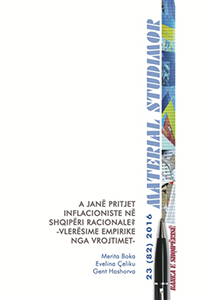Research Papers

The Research Papers consist of research studies and analyses on subjects related to theoretical and practical aspects, relevant for current and future economic and financial developments.
Note: The views expressed in the Research Papers are solely of the author/s and do not necessarily reflect those of the Bank of Albania.
Research Papers
Forecasting the Albanian short-term inflation through a Bayesian VAR Model
Authors: Meri Papavangjeli
In the context of the Bank of Albania’s primary objective of achieving and maintaining price stability, generating accurate and reliable forecasts for the future rate of inflation is a necessity for its successful realization.
An Estimation of the Natural Interest Rate in Albania
Authors: Eglent Kika, Olti Mitre
We estimate the natural rate of interest in Albania using the Bayesian Maximum Likelihood method and the Kalman Filter. The structure of the model used to identify the behaviour of the natural interest rate in time is based on the seminal work of Laubach and Williams (2003) and includes a joint estimation of the output gap and of potential growth.
The Albanian Medium Term Projection Model
Authors: Tibor Hledik, Eglent Kika, Olti Mitre
The Bank of Albania introduced a small semi-structural Medium-Term Projection Model (MPM) in 2013, as part of its forecasting toolkit, to support the monetary policy decision making process. This initial version of the model was built in 2011 in joint cooperation between the IMF, through a Technical Assistance (TA) program, and the Bank of Albania, in a bid to modernize the latter’s forecasting and policy analysis FPAS) and in conjunction with Bank of Albania’s strategic goal to move to a fully-fledged inflation targeting regime.
The global credit and Euro Area financial shocks: How important are they for Albania?
Authors: Bledar Hoda
Economies with open financial and capital account, high euroization and high foreign bank ownership are favorably exposed to global liquidity and foreign macro-financial shocks. In this study I assess how these forces have played out for Albania during the recent two decades.
Financial sector and macroeconomics links in MEAM
Authors: Lorena Skufi
This paper describes the links between financial sector and macroeconomic conditions into MEAM macro model. The focus is on banking lending rate, in terms of macroeconomic indicators impact, such as the probability of default of private sector and economic developments. Through this material we try to enrich MEAM macro model with financial indicators.
What drives the real lek-euro exchange rate fluctuations?
Authors: Altin Tanku, Ilir Vika
This study aims to assess the sensitivity of exchange rate to real and monetary shocks in Albania during the last 20 years. The identification of these shocks provides a better understanding on the sources of exchange rate volatility. It also provides useful information whether exchange rate acts as a shocks absorber or as a source of instability in the economy.
The impact of housing markets on banks’ risk-taking behavior: evidence from CESEE
Authors: Elona Dushku, Antje Hildebrandt, Erjona Suljoti
This study empirically evaluates the impact of housing market dynamics and banks’ housing market exposure on banking sector stability in Central, Eastern and Southeastern Europe (CESEE). We investigate whether there are differences between the behavior of banks located in CESEE EU Member States and the behavior of banks located in the Western Balkans.
Bank stability and its relationship with competition among banks after global financial crisis. New evidences from Albanian banking sector
Authors: Gerti Shijaku
This paper analyses the relationship between competition and banking stability in the Albanian banking sector during the period 2008 - 2017. For this reason, an index of banking competition, such as the Boone indicator, is constructed. Other alternative indicators are also calculated, such as: the Lerner index and adjusted Lerner index; and the competition indicator, which relates to profit elasticity.
Factors behind low inflation in Albania
Authors: Evelina Çeliku
This working paper explores the main factors contributing to low inflation in Albania in the post-crises years in an environment characterized by relatively stronger economic growth, lower unemployment rates and improved confidence.
The Price Formation Process in the Albanian Economy: A Macro Modelling Approach
Authors: Lorena Skufi, Eglent Kika
This paper provides the modelling framework of the price formation block in the macro econometric Albanian model (MEAM). MEAM is constructed on neo-Keynesian theoretical principles, implying a vertical long-run aggregate supply curve with aggregate demand factors impacting supply in the short-run.
11-20 / 114
Page 2 of 12

 Twitter
Twitter
 Youtube
Youtube
 Facebook
Facebook
 Flickr
Flickr
 RSS
RSS
 Subscribe
Subscribe
 Feedback
Feedback